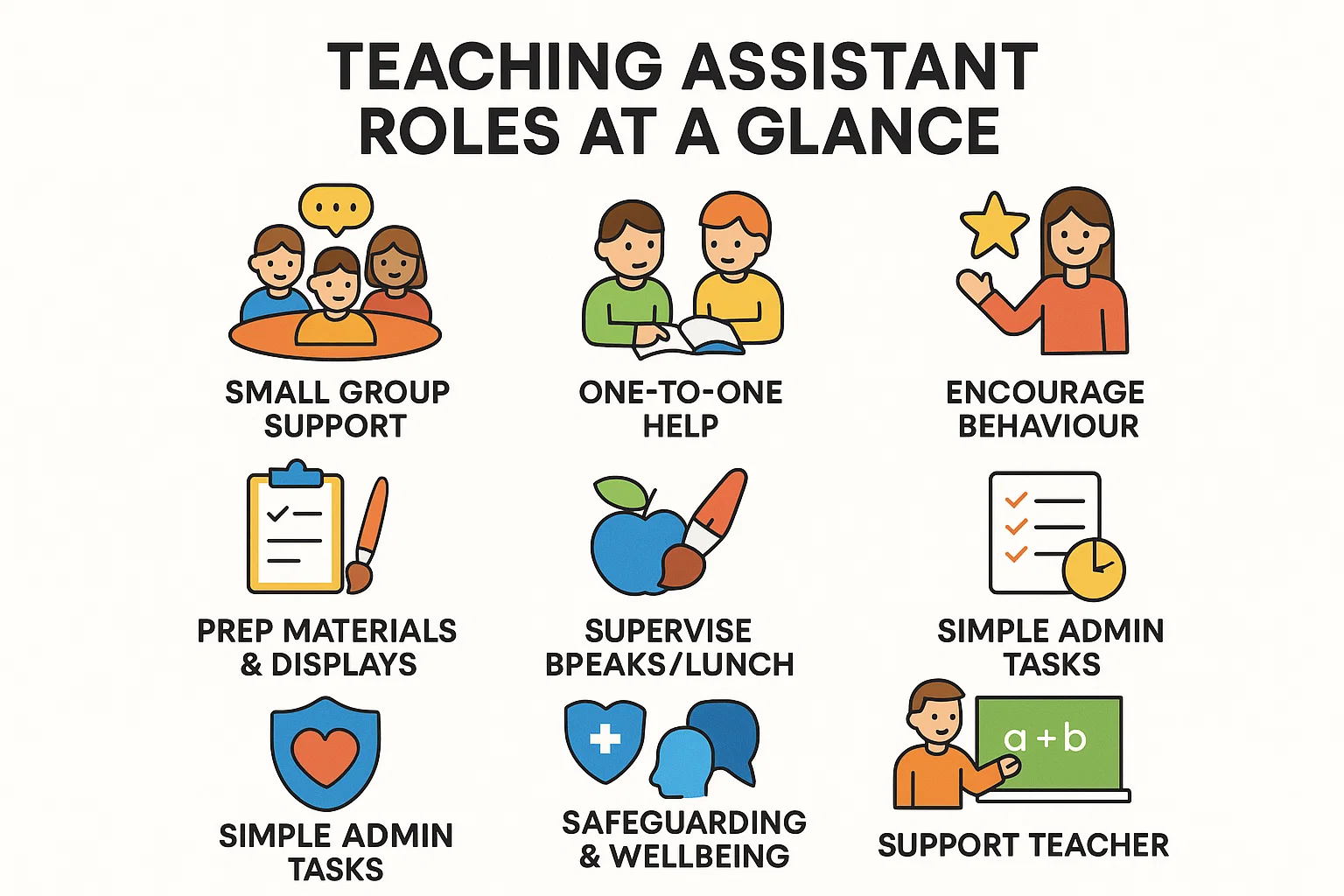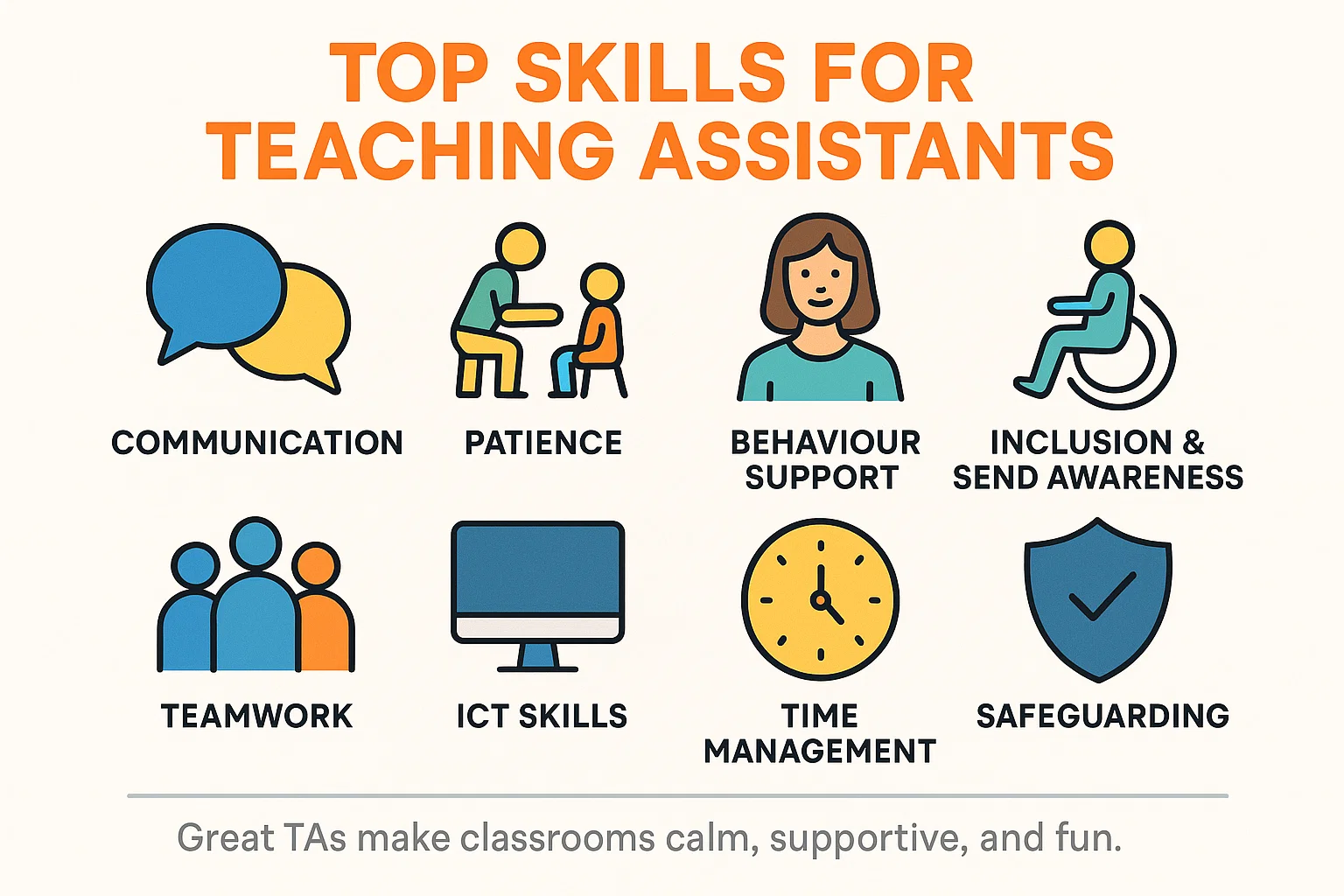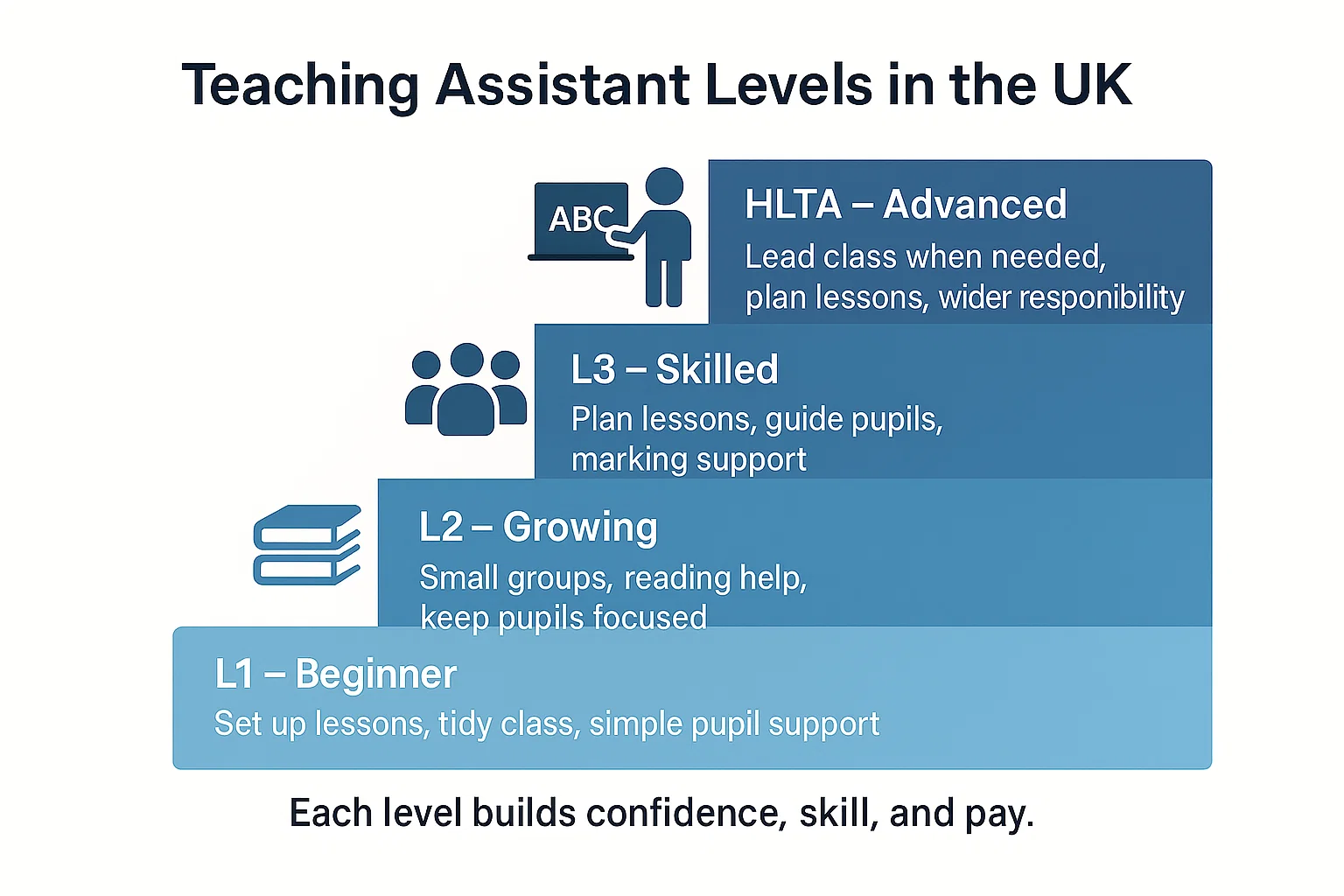No products in the cart.
So, what are teaching assistant roles all about? In simple words, a teaching assistant helps pupils learn, stay included, behave well, and feel happy in class. They also support teachers to deliver lessons and keep everything running smoothly each day. You might hear different job titles like teaching assistant (TA), learning support assistant (LSA), or learning mentor. But no matter the name, the goal stays the same — to help every pupil make real progress.
Being a TA is more than just helping in class. It’s about being the friendly face pupils can rely on when school feels tough. You encourage them, guide them, and celebrate every small win. Plus, you work closely with teachers to make lessons more fun and meaningful. That’s what makes this role so special — you play a big part in shaping young minds while supporting their growth every step of the way.
In this article, we explore teaching assistant roles in detail. You’ll learn what a TA really does in 2025, how their daily tasks support teachers and pupils, and why their role is so vital in schools today. We’ll also look at how TA titles can differ — from learning support assistant to learning mentor — and what skills you need to shine in this job. By the end, you’ll have a clear idea of what a teaching assistant does, how they make a difference, and whether this career could be the right fit for you.
What Is the Role of a Teaching Assistant in Schools?

So, what is the role of a teaching assistant in schools? In simple terms, TAs help pupils learn, stay focused, and feel supported every day. They work closely with teachers to make lessons run smoothly and pupils feel confident.
Here’s what teaching assistants do at a glance:
- Work with small groups to give extra learning support.
- Offer one-to-one help to pupils who need more guidance.
- Prepare classroom materials, displays, and lesson resources.
- Give behaviour prompts and encourage good manners.
- Supervise pupils during breaks, lunch, and transitions.
- Help with simple admin tasks like marking or recording progress.
- Stay alert to safeguarding responsibilities and pupil wellbeing.
- Always work under the teacher’s direction to support learning.
It’s helping pupils feel included, keeping lessons on track, and making school a happier, more supportive place for everyone.
What Are the Main Duties of a Teaching Assistant?
So, what do teaching assistants do every day? Their role is busy, hands-on, and full of heart. They help teachers, support pupils, and make lessons run smoothly from start to finish.
First, TAs set up the classroom. They prepare activities, organise books and materials, and make sure everything is ready before lessons begin. After class, they help tidy up so the space feels calm and welcoming. During lessons, they give one-to-one or small group support. They explain tricky parts, model tasks, and cheer pupils on when learning feels tough. They also take notes and watch how pupils learn so teachers can track progress and plan next steps.
TAs often run short reading sessions or help with learning tasks. When pupils have SEND (special educational needs or disabilities), they adjust materials or explain things in simpler ways so everyone can join in. They also make displays, prepare resources, and keep simple records. Most importantly, they share updates with teachers about how pupils are doing.
If you love helping young children and enjoy early learning activities, your skills as a TA can also fit perfectly in a nursery setting. You can explore all that in our full guide “Can a Teaching Assistant Work in a Nursery?”. It explains how teaching assistants can support early years education and start rewarding careers with young learners.
How Do Teaching Assistant Roles Differ in Primary and Secondary Schools?
When we talk about teaching assistant roles, they can be a bit different in primary and secondary schools. The main job is the same — helping pupils learn, stay happy, and feel confident — but what a TA does each day can change.
Here’s how:
Primary Teaching Assistant Roles
- Stay in one classroom with the same pupils for most of the day.
- Help with phonics, early reading, and simple maths.
- Support the whole class during lessons.
- Work with small groups or one-to-one with pupils.
- Help with EYFS routines like playtime and snack breaks.
- Create fun displays and prepare learning activities.
- Give extra help to SEN pupils who need more support.
Secondary Teaching Assistant Roles
- Move between classes and different subjects like English or science.
- Support many pupils across different lessons.
- Help with exam support and revision time.
- Encourage good behaviour and focus in class.
- Talk with teachers about how pupils are doing.
- Support older SEN pupils to work more independently.
So, when we think about primary TA vs secondary TA, both roles are important. Each one helps pupils learn, grow, and feel proud of what they can do.
What Skills Do You Need to Succeed as a Teaching Assistant?

So, how to be a good teaching assistant? It’s not only about helping the teacher. It’s about having the right mix of people skills, patience, and care. A good TA makes the classroom a friendly, calm, and fun place to learn.
Here are the key teaching assistant skills you need to shine:
- Good communication: Speak clearly, listen carefully, and explain ideas in simple, kind ways.
- Patience: Stay calm when pupils struggle or need extra help.
- Behaviour support: Guide pupils with care and help them stay focused during lessons.
- Inclusion and SEND awareness: Support every child, especially those with special educational needs or disabilities.
- Teamwork: Work closely with teachers and share ideas to keep learning smooth.
- Basic ICT skills: Use computers to prepare lessons or track progress easily.
- Time management: Stay organised to handle many tasks without stress.
- Confidentiality and safeguarding: Always protect pupils’ safety and privacy.
So, what do you need to be a teaching assistant? A caring heart, strong communication, and the drive to make every pupil feel valued and supported.
Do Teaching Assistant Roles Include Supporting SEN Pupils?
Yes, many teaching assistant roles include helping children with Special Educational Needs (SEN). These children sometimes need extra care to learn, stay calm, and feel happy at school. A kind and patient SEN teaching assistant helps make that happen.
If you’re thinking about how to become a SEN teaching assistant, you just need a caring heart, patience, and the right training. Every child is different, so you learn to support them in ways that work best for them. Find out how much SEN teaching assistants earn in our easy guide.
Here’s what SEN support often includes:
- One-to-one help: Sitting beside a pupil to guide them through lessons.
- Talking and listening: Using simple words, pictures, or signs like PECS or Makaton if trained.
- Visual help: Showing pictures, charts, or symbols to make ideas clearer.
- Calm breaks: Giving short breaks to help pupils relax and refocus.
- Step-by-step help: Breaking big tasks into small, easy steps.
- Teamwork: Working with the SENDCo and other helpers to support each pupil’s needs.
Every SEN teaching assistant helps children feel safe, supported, and proud of what they can do.
How Do Teaching Assistant Levels (L1, L2, L3, HLTA) Change the Role?

Teaching assistant roles grow step by step as you learn more. Each level gives you new jobs to do and a better pay rate. Here’s an easy look at how it works:
- Level 1 Teaching Assistant:
This is the beginner level. You help the teacher set up lessons, tidy the classroom, and give simple support to pupils. It’s a great way to start and learn the basics. - Level 2 Teaching Assistant:
So, what is a Level 2 teaching assistant? At this level, you work a bit more on your own. You might help small groups, listen to children read, and remind them to stay focused. - Level 3 Teaching Assistant:
What is a Level 3 teaching assistant? Here, you help plan lessons, prepare materials, and guide pupils who need extra help. You also support the teacher with marking or feedback. - Higher Level Teaching Assistant (HLTA):
An HLTA can lead the class when the teacher is away. They help plan lessons and support pupils’ learning with more freedom.
Each level helps you grow in confidence and skill — showing that every TA plays an important part in helping pupils learn and succeed.
What Are the Day-to-Day Tasks of a Teaching Assistant?
Ever wondered what does a teaching assistant do every day? Their days are full, busy, and full of heart. Each moment counts when helping pupils learn, grow, and smile.
A typical day starts early. The teaching assistant sets up the classroom, arranges books, and gets learning materials ready. They greet pupils with a friendly smile, helping everyone settle in for the day.
During lessons, they move around the classroom, giving quiet support to those who need help. They explain tricky tasks, keep pupils focused, and cheer them on when learning feels hard. Sometimes, they run small group sessions or one-to-one activities to boost confidence.
At break or lunch, TAs often help on the playground — watching that everyone stays safe, plays kindly, and feels included. Later, they prepare resources, update displays, or make notes for the teacher about how pupils are doing. They also stay alert to safeguarding, making sure every child feels safe and cared for.
So, what do teaching assistants do? A bit of everything — teach, guide, listen, and care. Their hard work keeps classrooms running smoothly and children learning happily every day.
Do Teaching Assistants Only Work Term-Time?
Most teaching assistants work only during term-time, which means they work when schools are open and get holidays off. It’s one big reason many people love this job — it gives more family time and a good work-life balance.
A term-time teaching assistant does not get full-year pay. Instead, the pay is based on the number of weeks they work. The school usually spreads this pay over 12 months, so you get a regular monthly income.
Some teaching assistants choose to work extra hours. They may help with after-school clubs, lunchtime duty, or wraparound care. These extra jobs can add more hours and a bit more pay to your teaching assistant salary (term-time).
So, how much do teaching assistants get paid? It depends on the school, your level, and the hours you work. Overall, working term-time is great for people who want a meaningful job and time to rest during school holidays. It’s a job that fits well with family life and still makes a real difference every day.
How Do Teaching Assistant Roles Support Teachers and Pupils?
A teaching assistant’s role is full of teamwork and care. They help both teachers and pupils every day, making the classroom calm, happy, and ready for learning.
So, how does a teaching assistant support the teacher? Here’s how they make a big difference:
- Prepare lessons: Set up books, worksheets, and learning tools before class starts.
- Keep things organised: Tidy up, manage resources, and help with classroom displays.
- Handle small admin jobs: Print worksheets, collect homework, or note pupil progress.
And when it comes to helping pupils, teaching assistants do even more:
- Give one-to-one help: Sit with pupils who need extra support to understand the lesson.
- Run small group tasks: Help pupils practise reading, writing, or maths in small groups.
- Encourage good behaviour: Gently remind pupils to stay calm and focused.
- Boost confidence: Cheer pupils on and help them believe in themselves.
These teaching assistant responsibilities help teachers focus on teaching while pupils get the support they need to learn and grow.
What Is the Career Progression for Teaching Assistants?
Working as a teaching assistant is a great way to start a career in education. The best part? You can grow step by step while gaining real classroom experience. Here’s how your path can look:
- Teaching Assistant (TA): Start by helping pupils and teachers every day. Learn how the classroom works.
- Senior TA: Take on more duties, guide new TAs, and support pupils with extra needs.
- Higher Level Teaching Assistant (HLTA): Wondering how do I become a higher-level teaching assistant? You’ll need extra training and experience. HLTAs help plan lessons and can lead the class when the teacher is away.
- Specialist Roles: You can also focus on areas like SEN, ELSA (emotional support), or behaviour support. These roles make a big difference to pupils who need extra help.
- Teacher Training: Many TAs move on to become teachers. If you’re thinking how to become a teacher from a teaching assistant, you can take routes like PGCE, QTS, or an apprenticeship.
With the right courses and strong references, you can move up faster — turning your TA job into a full teaching career.
FAQs About Teaching Assistant Roles in the UK
- What are the roles of a teaching assistant?
Teaching Assistants (TAs) help teachers and pupils by setting up classrooms, supporting lessons, and giving extra help to children, especially those with special needs.
- Is Being a TA a Good Job?
A teaching assistant (TA) job is rewarding and meaningful, perfect for those who care, love helping others, and want to make a difference in children’s lives.
- What qualities make a good teaching assistant?
A good teaching assistant needs patience, strong communication, flexibility, and good organisation to support pupils and teachers effectively.
- How many hours a day does a TA work?
Most full-time teaching assistants work 32.5 to 37 hours a week, usually 8:30 a.m. to 3:30 or 4:00 p.m., Monday to Friday. This includes lessons, lunch duty, and end-of-day tasks.
- How much does a TA get paid per hour?
The average teaching assistant salary in the UK ranges from £12,500 to £21,200 a year, with an average hourly rate of about £7.30. Pay can vary by region and experience.
Final Thoughts: Is a Teaching Assistant Role Right for You?
Being a teaching assistant in 2025 is more than a job — it’s a chance to change lives every single day. From helping pupils stay focused to supporting teachers in the classroom, TAs play a vital role in schools. The career also offers clear progression, from entry-level roles through to HLTA and even teacher training pathways.
If you’re ready to start your journey, the next step is the right training. At Open Learning Academy, you can join our Teaching Assistant Course and gain the skills, confidence, and qualifications to succeed. Whether you’re starting fresh or aiming to move up, this course gives you the knowledge to shine in class and build a rewarding career in education.
Take the first step today — your future in teaching starts here.




